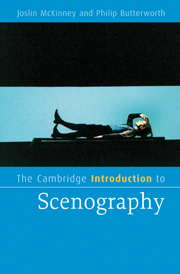Book contents
- Frontmatter
- Contents
- List of illustrations
- List of boxed quotations
- Preface
- Acknowledgements
- Part 1 Elements
- Chapter 1 What is scenography?
- Chapter 2 Twentieth-century pioneers of scenography
- Part 2 Processes of scenography
- Part 3 Realisation and reception
- Notes
- Bibliography
- Index
- Cambridge Introductions to …
Chapter 1 - What is scenography?
Published online by Cambridge University Press: 05 February 2015
- Frontmatter
- Contents
- List of illustrations
- List of boxed quotations
- Preface
- Acknowledgements
- Part 1 Elements
- Chapter 1 What is scenography?
- Chapter 2 Twentieth-century pioneers of scenography
- Part 2 Processes of scenography
- Part 3 Realisation and reception
- Notes
- Bibliography
- Index
- Cambridge Introductions to …
Summary
The origins of the term ‘scenography’ are associated with both scene painting and architectural perspective drawing. In the twentieth century the term has gradually gained currency by drawing attention to the way stage space can be used as a dynamic and ‘kinaesthetic contribution’ to the experience of performance. This suggests a difference in intention from the static and pictorial scene design of previous centuries. Architect and scenographer João Mendes Ribeiro says that scenography is concerned primarily with the ‘inhabitability of the space’; that is, the creation of spaces with which performing bodies can interact: ‘The scenographic concept, as currently understood by the majority of artists, is a far cry from the pictorial two-dimensional scenography and focuses much more on the three-dimensional (architectural) nature of the space or the scenic object and its close relationship with the performers.’ Contemporary use of the term has also been influenced by the work of theatre designers such as Josef Svoboda. His concern with the actualisation of a play rather than the decoration of the stage underlines the need to consider scenography as a component of performance: ‘True scenography is what happens when the curtain opens and can't be judged in any other way.’
My great fear is that of becoming a mere ‘décorateur.’ What irritates me most are such terms as ‘Bühnenbildner’ or ‘décorateur’ because they imply two-dimensional pictures or superficial decoration, which is exactly what I don't want. Theatre is mainly in the performance; lovely sketches and renderings don't mean a thing, however impressive they may be; you can draw anything you like on a piece of paper, but what's important is the actualization. […]
- Type
- Chapter
- Information
- The Cambridge Introduction to Scenography , pp. 3 - 8Publisher: Cambridge University PressPrint publication year: 2009
- 1
- Cited by

